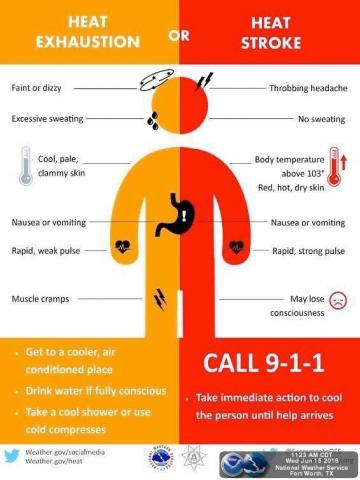July/August 2023
Heat-related illnesses are preventable. Take precautions to protect yourself, your loved ones, and your pets from the heat, especially if you must be outdoors for prolonged periods during the warmest hours of the day.
Learn the symptoms and what to do if you or a loved one shows signs of having a heat-related illness.
What is Extreme Heat?
Extreme heat is defined as summertime temperatures that are much hotter and/or humid than average. Because some places are hotter than others, this depends on what’s considered average for a particular location at that time of year. Humid and muggy conditions can make it seem hotter than it really is.
Summertime activity, whether on the playing field or the construction site, must be balanced with actions that help the body cool itself to prevent heat-related illness.
Heat-related illnesses, like heat exhaustion or heat stroke, happen when the body is not able to properly cool itself. While the body normally cools itself by sweating, during extreme heat, this might not be enough. In these cases, a person’s body temperature rises faster than it can cool itself down. This can cause damage to the brain and other vital organs.
Beat the heat with these helpful tips!
Cooling Center Locator Map (Texas Division of Emergency Management)
Tips for Preventing Heat-Related Illnesses (Center for Disease Control & Prevention (CDC))
Warning Signs & Symptoms of Heat-Related Illness (CDC)
Heat & Working Outdoors (CDC)
Protecting Infants & Children from Heat (CDC)
Heat & Older Adults (CDC)
Heat & People with Chronic Medical Conditions (CDC)
Heat & Low-Income Populations (CDC)
Heat & Athletes (CDC)
Heat & Pets (CDC)
Protect Your Pets from Heat (Red Cross)
Frequently Asked Questions (FAQ) About Extreme Heat (CDC)
Prepare Your Home to Beat the Heat (SafeElectricity.org)
Maintenance Checklist (EnergyStar.gov)
